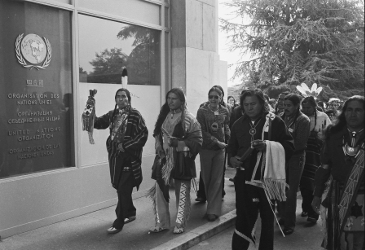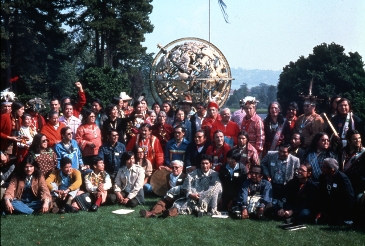The process of pursuing recognition of Indigenous Peoples' rights continues beyond the 1970s and 1980s. For example, the proposal to create a permanent forum on indigenous issues originates at the Vienna World Conference on Human Rights in 1993, and its establishment becomes one of the central objectives of the programme of activities of the International Decade of the World's Indigenous Peoples (1995-2004). In order to discuss the possibility of a permanent forum, two workshops are held: the first in Copenhagen (Denmark) in 1995 (see report E/CN.4/Sub.2/AC.4/1995/7) and the second in Santiago de Chile in 1997.
In February 1999, an ad hoc Working Group of the Commission on Human Rights meets in Geneva to draft proposals to create this forum. A second ad hoc Working Group meets the following year, in February 2000, to draft a proposal for the Commission on Human Rights. At its 56th Session, the Commission on Human Rights then recommends that the Economic and Social Council (ECOSOC) set up a permanent forum on indigenous issues. On 28 July 2000, ECOSOC adopts a resolution establishing the Permanent Forum on Indigenous Issues (UNPFII). Furthermore, the proposal to create the Expert Mechanism on the Rights of Indigenous Peoples (EMRIP) was established on 14 December 2007 by resolution A/HRC/6/36 of the Human Rights Council (HRC). The EMRIP replaces the Working Group on Indigenous Populations (WGIP) of the former Subcommission on Promotion and Protection of Human Rights.
Another significant new entity appearing at the international level during this time is the United Nations Voluntary Fund for Indigenous Peoples, which is established by General Assembly resolution 40/131 of 13 December 1985. This Fund is originally designed to provide financial assistance for indigenous delegates wishing to participate in discussions of the Working Group on Indigenous Populations of the Subcommission on the Promotion and Protection of Human Rights. In 2001, the General Assembly decides to expand its mandate (resolution 56/140) so that indigenous delegates may participate in the Permanent Forum on Indigenous Issues. Resolution 63/161 further extends the mandate to cover the Expert Mechanism on the Rights of Indigenous Peoples, and resolution 65/198 of 21 December 2010 extends it to sessions of the Human Rights Council and of human rights treaty bodies.
In 2001, the Commission on Human Rights begins to consider the idea of creating a Special Rapporteur on the rights of indigenous peoples. By resolution A/HRC/6/L.26 of 24 September 2007, submitted by Guatemala, the Council renews the mandate of the Special Rapporteur on the situation of human rights and fundamental freedoms of indigenous peoples. At its 15th session, on 20 September 2010, the Council adopts without a vote a resolution changing the name to "United Nations Special Rapporteur on the Rights of Indigenous Peoples", a position currently held by Ms. Victoria Tauli Corpuz.
Subsequently, after more than 30 years of discussions and work, the draft of a Declaration on the rights of indigenous peoples becomes a reality. On 29 June 2006, the Human Rights Council adopts the United Nations Declaration on the Rights of Indigenous Peoples, and this international normative text is solidified by the General Assembly on 13 September 2007. Although the Declaration has no binding force, it contains key guiding principles for the promotion and defence of the rights of Indigenous Peoples.
Finally, the first World Conference on Indigenous Peoples, which was held on 22 September 2014 at the UN in New York, is considered to be another significant milestone on this journey. The plan for this two-day conference with Member States and Indigenous Peoples, a high-level General Assembly plenary session, was originally agreed on 16 November 2010, at the Third Committee of the United Nations General Assembly (resolution A/C.3/65/L.22/Rev.1). Indigenous delegates from 7 regions of the world carried out a considerable amount of preparation for the conference, including a meeting held in June 2013 in Alta, Norway, in order to establish a common position. Initiated by the Sámi Parliament of Norway, this conference produced the "Alta Outcome Document", which contains recommendations to the States.










